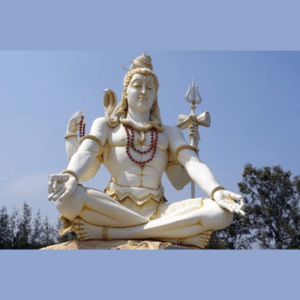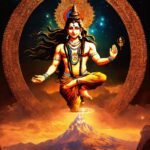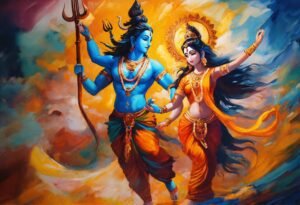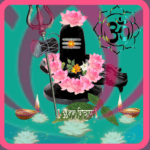Maha Shivaratri: Celebrating the Great Night of Shiva

Maha Shivaratri, also known as the Great Night of Shiva, is a Hindu festival celebrated with great enthusiasm and reverence across the world. This auspicious moonless night, dedicated to the veneration of Lord Shiva, marks a powerful convergence of cosmic energies and a profound opportunity for inner transformation. It holds significant spiritual and cultural importance in the Hindu tradition, symbolizing the overcoming of darkness and ignorance. As we delve into the essence of Maha Shivaratri, let’s explore its symbolism, rituals, and the path it illuminates towards spiritual awakening.
Understanding Maha Shivaratri
The term “Maha Shivaratri” translates to “The Great Night of Shiva.” It falls on the 14th day of the dark fortnight in the Hindu month of Phalguna or Magha (February-March). The auspicious timing aligns with a natural upsurge of energy within the human system, making it a potent night for spiritual practices.
The Tandava: Shiva’s Cosmic Dance
Maha Shivaratri is dedicated to Lord Shiva, the supreme deity in Shaivism. It marks the day when Lord Shiva is believed to have performed the Tandava, a cosmic dance that reverberates through the universe. This dance represents the eternal cycle of birth, death, and rebirth. As Shiva swirls in ecstatic rhythm, he dissolves the illusions of existence, inviting devotees to witness the impermanence of life. The Tandava embodies both destruction and creation—a reminder that every ending births a new beginning.

Spiritual Significance of Maha Shivaratri
Maha Shivaratri holds profound spiritual significance beyond its religious observance. Shiva, in Hinduism, embodies the transformative power that dissolves the old and makes way for the new. Devotees observe this day to seek blessings for inner peace, wisdom, and liberation from the cycle of birth and death. This festival serves as a reminder of the following:
Detoxification of the Soul
The festival symbolizes the triumph of light over darkness, knowledge over ignorance, and good over evil. It encourages individuals to introspect, let go of negativities, and purify their minds and souls. It is an opportunity for spiritual rejuvenation and inner transformation.
Seeking Blessings for Inner Peace
The night-long vigil represents the transcendence of the limitations of the ego-mind and an awakening to the boundless consciousness within. Devotees seek Lord Shiva’s blessings for inner peace, harmony, and enlightenment. They aspire to transcend worldly attachments and attain spiritual liberation.
Spiritual Growth:
The fasting and offerings encourage us to cultivate self-discipline, detachment, and surrender to the divine. The darkness of our own limitations, fears, and attachments dissolves in the luminous presence of Shiva. As we seek his grace, we strive to embody virtues like honesty, forgiveness, and compassion.
Legends and Symbolism

The Samundra Manthan
The festival’s origin is rooted in Hindu mythology, particularly in the legend of the churning of the ocean (Samudra Manthan). According to mythology, during the churning, a pot of poison emerged, threatening to destroy the world. To save the universe, Lord Shiva consumed the poison but held it in his throat, turning it blue. As a result of this incident, he is known as “Neelkanth”, which means “the one with the blue throat”.
The Wedding of Shiva and Parvati
Another legend speaks of Maha Shivaratri as the night of the celestial union of Lord Shiva and Goddess Parvati. According to Hindu mythology, this auspicious night marks their divine wedding. Parvati, the embodiment of grace and devotion, won the heart of the ascetic Shiva through her unwavering love. Their union symbolizes the harmonious balance of masculine and feminine energies, between consciousness and creation — the cosmic dance of creation and dissolution.
Rituals and Traditions
Fasting
Devotees observe a strict fast on Maha Shivaratri, abstaining from food and water for the entire day or consuming only fruits and milk. Fasting symbolizes self-discipline, purification of body and mind, and the control of worldly desires.
Nightlong Vigil (Jagran)
One of the highlights of Maha Shivaratri is the nightlong vigil spent in devotion to Lord Shiva. Devotees engage in prayers, chanting of mantras, and singing bhajans, devotional singing, meditation, throughout the night, symbolizing wakefulness of the soul and the conquest of darkness.
Worship of Shiva Lingam
Shiva temples become vibrant centers of celebration. Devotees visit temples to offer prayers to the Shiva Lingam, representing the cosmic energy of Lord Shiva. The Lingam signifies both the formless and the manifest—the unchanging consciousness within all forms. Devotees bathe the Lingam with milk, honey, yogurt, ghee, and water, and offer Bilva Leaves and flowers symbolizing purification and the offering of the five elements to the divine.

Celebrations Across India
Maha Shivaratri is celebrated fervently across India, with each region adding its unique cultural flavor to the festivities.
Varanasi, India
Varanasi, the city of Lord Shiva, witnesses grand celebrations during Maha Shivaratri. Devotees throng the Kashi Vishwanath Temple to offer prayers and seek blessings.
Pashupatinath Temple, Nepal
In Nepal, the Pashupatinath Temple in Kathmandu becomes the focal point of Maha Shivaratri celebrations. Thousands of devotees gather to pay homage to Lord Shiva and participate in rituals.
Importance of Meditation and Introspection
Maha Shivaratri emphasizes the practice of meditation and introspection as essential tools for spiritual growth and self-realization. It encourages individuals to delve deep into their consciousness and connect with the divine within.
Maha Shivaratri and Yoga
Yoga holds a special significance on Maha Shivaratri, as Lord Shiva is considered the Adi Yogi, the first yogi. As the night deepens, devotees engage in yoga asanas, pranayama (breath control), and meditation to enhance physical, mental, and spiritual well-being. They seek union with the divine, transcending the limitations of the physical body. The stillness of meditation mirrors Shiva’s tranquil presence.
How to Celebrate Maha Shivaratri
Whether you are a devout Hindu or simply curious about spiritual traditions, here are ways to meaningfully participate in Maha Shivaratri:
- Setting up a Sacred Space at Home : Create a sacred space at home with a Shiva Lingam or pictures of Lord Shiva and Parvati. Light incense sticks, offer flowers, and keep the atmosphere serene.
- Fasting Recipes: Prepare dishes using ingredients allowed during fasting, such as sabudana khichdi, kuttu ki puri, and fruits.
- Prasad Offerings: Offer homemade sweets like kheer, halwa, and ladoos as prasad to Lord Shiva and distribute among family and friends.
- Performing Puja Rituals : Follow traditional puja rituals, including offering bilva leaves, water, milk, honey, and fruits to Lord Shiva. Chant mantras and prayers with utmost devotion.
- Introspection:Take time for quiet reflection. Examine your patterns, habits, and beliefs that may be holding you back.
- Meditation:Practice meditation or mindfulness techniques to still the mind and connect with your inner source of peace.
- Acts of Compassion:Extend kindness and support to those in need.
- Learn:Delve into the mythology and philosophy surrounding Shiva and Maha Shivaratri.
Impact of Maha Shivaratri on Communities
Maha Shivaratri fosters a sense of community and solidarity among devotees, transcending barriers of caste, creed, and religion.
Social Gatherings
Communities come together to organize bhajan recitals, cultural programs, and charitable activities, promoting unity and compassion.
Charity and Donations
Many devotees engage in acts of charity and donate to the less fortunate, reflecting the spirit of generosity and empathy.
Maha Shivaratri in Contemporary Times
In modern times, Maha Shivaratri continues to inspire people from all walks of life, irrespective of religious affiliations.
Modern Interpretations
The festival has evolved to accommodate contemporary lifestyles, with digital platforms enabling virtual satsangs and online meditations.
Influence on Art and Culture
Maha Shivaratri has inspired artists, poets, and musicians to create works of art, poetry, and music celebrating the divine attributes of Lord Shiva.
Conclusion
Maha Shivaratri invites us to shed our illusions, embrace the dance of existence, and seek the eternal within. As we chant “Om Namah Shivaya,” let us remember that this night is not merely about rituals; it is an invitation to awaken the Shiva within us—the consciousness that transcends time and space.
May the divine grace of Lord Shiva illuminate our hearts, dispelling darkness, and leading us toward eternal truth.
Frequently Asked Questions
- What is the purpose of fasting on Maha Shivaratri?
Fasting symbolizes self-discipline, purification, and spiritual detoxification.
- How do yoga practices enhance Maha Shivaratri celebrations?
Yoga connects individuals with their inner selves and accelerates spiritual progress.
- What are some traditional foods eaten during Maha Shivaratri?
Sabudana khichdi, kuttu ki puri, and fruits are commonly consumed during fasting.
- How does Maha Shivaratri promote community bonding?
The festival encourages social gatherings, charity, and acts of compassion among communities.
- When is Maha Shivaratri this year?
It is on Friday, 8th March 2024.


Hi there! This post couldn’t be written any better! Reading through this post reminds me of my previous room mate! He always kept talking about this. I will forward this article to him. Pretty sure he will have a good read. Thank you for sharing!
I like this web blog very much, Its a really nice billet to read and obtain info .
I truly appreciate this post. I¦ve been looking everywhere for this! Thank goodness I found it on Bing. You’ve made my day! Thank you again
Perfectly pent content, appreciate it for selective information. “He who establishes his argument by noise and command shows that his reason is weak.” by Michel de Montaigne.
I too conceive hence, perfectly composed post! .